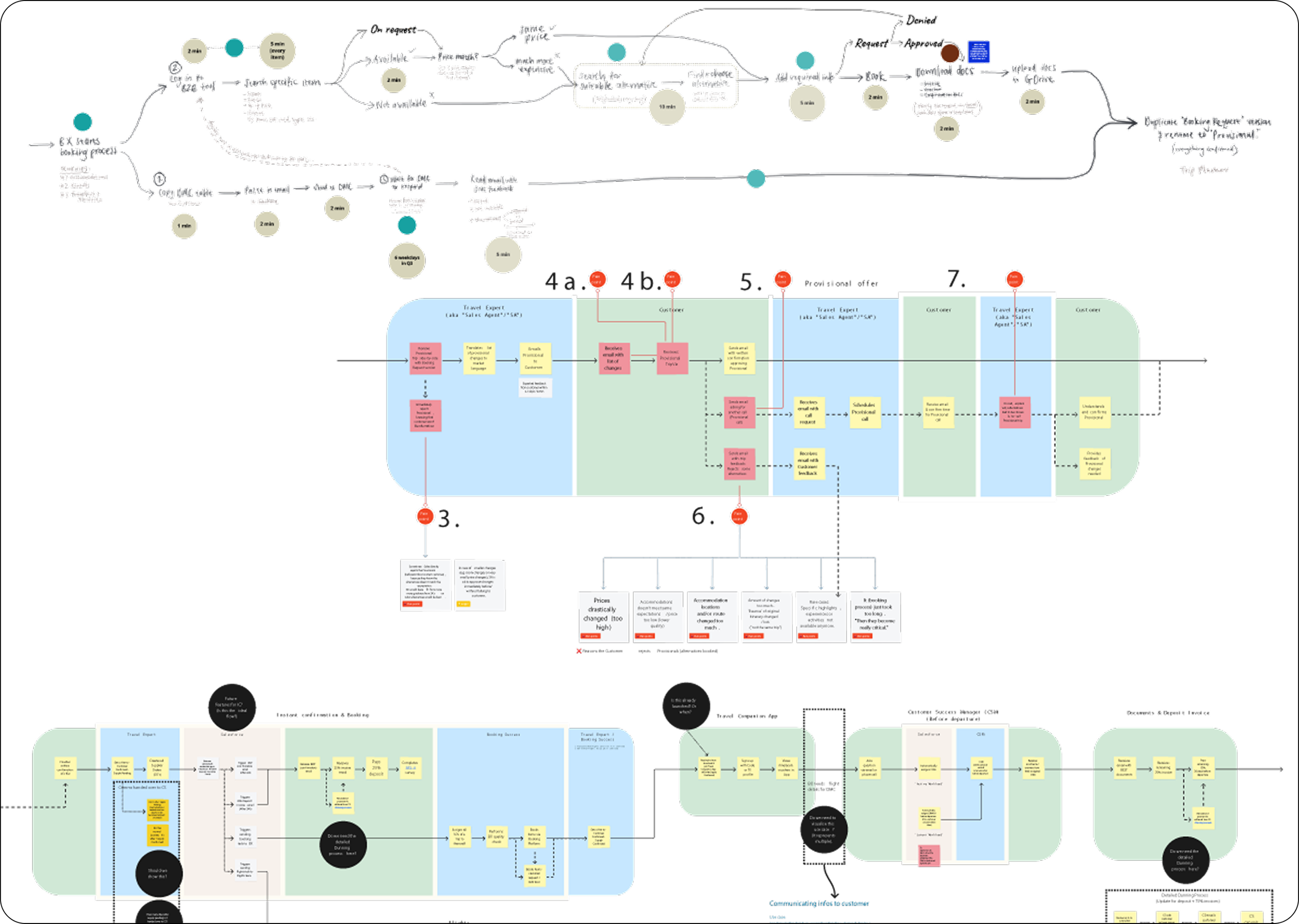We achieved profitability at Tourlane by scaling design maturity, reducing booking times, and improving conversion rates.
1.
Project
Overview
1.1
Context
-
Tourlane is a Berlin-based online travel agency offering bespoke, multi-stop trips to destinations like South Africa, Iceland, and Costa Rica.
-
As Head of Design, I led the product and brand design efforts across customer-facing platforms, internal tools, and marketing.
-
To elevate UX maturity, improve conversion rates, and reduce internal inefficiencies—all aligned with the company’s strategic goal of profitability.
1.2
Responsibilities
-
Managing a team of 9 Designers and scaling with strategic hires.
-
Launched a service blueprint, introduced user testing, transitioned the design system to Material Design 3, and led a full rebrand initiative.
-
Collaborated cross-functionally across squads and departments, embedding user-centered design into agile rituals and quarterly/annual planning.
1.3
Collaboration & Planning
-
Worked daily with Product, Engineering, Marketing, Sales, and Operations to align Customer Experience (CX) and Employee Experience (EX) journeys.
-
Led the design team’s transition from Sketch and Zeplin to Figma; supported company-wide collaboration using Miro, Jira, and Confluence.
-
2-week sprints, quarterly OKR planning, fortnightly Town Halls, and participation in annual strategic roadmap planning.
2.
Challenges
& Constraints
2.1
External Challenges
-
The user journey ended prematurely after collecting email and phone numbers, failing to meet expectations and causing steep drop-offs.
-
Complex trips were planned manually using spreadsheets and emails, contributing to long booking cycles and high internal costs.
-
Tourlane lacked strong visual differentiation or a unified brand voice to build user trust.
2.2
Internal Challenges
-
No consistent user testing or research practices; stakeholders viewed UX as “UI polish” rather than a strategic partner.
-
Multiple internal component libraries, lacking accessibility and visual coherence, caused significant engineering overhead.
-
Marketing had limited design support, leading to burnout and inconsistent visual output.
2.3
Constraints
-
The CPTO and Head of Product both left within six months of my arrival, shifting strategy mid-stream.
-
Decisions were often reactive and data was interpreted prematurely; UX timelines were compressed to fit a performance marketing mindset.
-
Addressed legacy hiring decisions, including a difficult probation review and subsequent offboarding.
3.
Strategy
& Process
3.1
Strategic Foundations
-
Initiated and maintained a blueprint mapping both the customer and employee journeys, which was used as a strategic anchor across the business.
-
Introduced Lead roles for Customer and Employee Experience design, aligning teams to journey logic rather than functional silos.
-
Regularly presented research at Town Halls and executive strategy meetings, positioning design as a business-critical function.
3.2
Operational Improvements
-
Migrated the team to Figma and Material Design 3, standardising UI while reducing engineering maintenance burdens.
-
Created an open request process for testing via Slack; centralised research documentation on Confluence; gained adoption across Marketing, Finance, and beyond.
-
Introduced “Marketing Fridays” where product designers supported marketing initiatives, fostering a culture of teamwork and shared responsibility.
3.3
Product & Brand Evolution
-
User recordings and A/B testing were used to validate changes in signup logic, reducing drop-off and increasing user clarity.
-
Designed and validated itinerary customisation tools that increased engagement and purchase intent before users spoke to agents.
-
Reimagined Tourlane’s visual identity using accessible colour systems and a nod to its heritage green, laying the foundation for a full rebrand.
4.
Solution
& Implementation
4.1
Customer Experience (CX) Improvements
-
Enhanced the conversion funnel with tested call-to-actions, preview itineraries, and call-scheduling features.
-
Built and tested prototypes for user-driven itinerary customisation—prioritised as a top business OKR.
-
Created multiple customer journey archetypes to address diverse needs, expanding the product's reach and relevance.
4.2
Employee Experience (EX) & Operational Enhancements
-
Designed booking tools around supplier APIs to replace manual workflows—cutting booking time from 18 days to 4 days.
-
Mapped agent workflows to identify time loss and prioritise automation, informing OKRs and reducing cost per booking.
-
Mentored and promoted a Lead Designer in EX who deeply embedded design into operations and tools.
4.3
Organisational & Cultural Shifts
-
Shifted the company from NN/g maturity stage 2 to 4 through blueprinting, testing, and shared UX processes.
-
Finance and Marketing used testing to shape offerings (e.g., cancellation policy pricing), leading to new revenue streams.
-
Built a self-sustaining, high-trust design culture through structured feedback rituals, async collaboration, and peer mentorship.
5.
Outcomes
& Impact
5.1
Business Outcomes
Profitability
EBITA -positive
Tourlane reached full profitability in Q1 2024.
Lead Growth
600%
Monthly increase from 7,000 to 50,000.
Revenue Growth
50%
From €6.2M in Feb 2022 to €12.2M in Feb 2024.
5.2
Efficiency Gains
Time-to-Booking
78%
Booking time reduced from 18 days to 4 days within one month of launch.
Conversion Lift
3%
Reduced booking drop-off increased conversion by 3 percentage points.
New Revenue
€69k
Flexible cancellation policy tested and launched, earning €69k in two months.
5.3
Lasting Impact
-
This became core to planning across departments, including Finance.
-
User testing and journey mapping became expected, not exceptional.
-
Design became a trusted, collaborative partner, valued for clarity, consistency, and care.
6.
Project
Evidence
Other
Projects
Telecoms
Principal Service Designer
Operational efficiency
Support call volume
Customer satisfaction
Finance
Product Design Lead
Conversion rates
Internal efficiencies
Platform alignment














